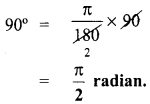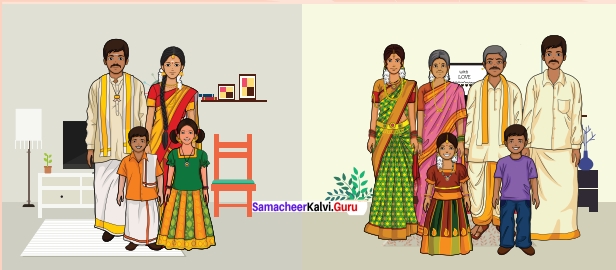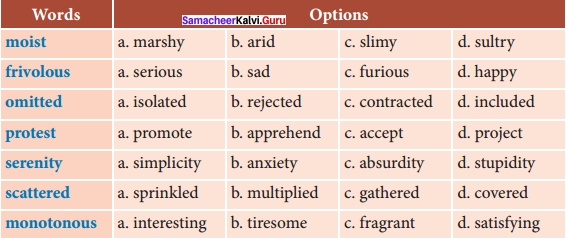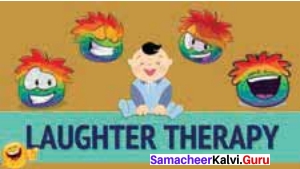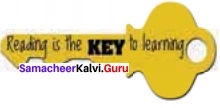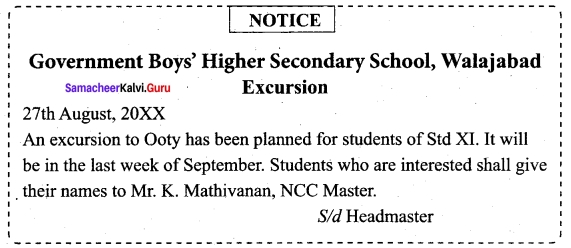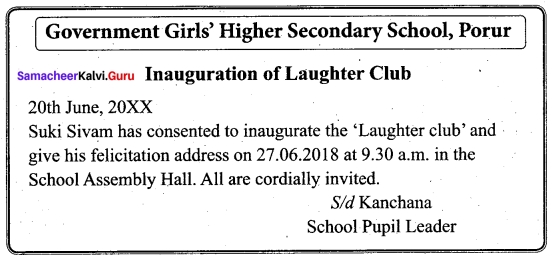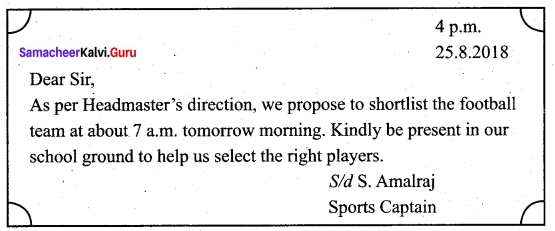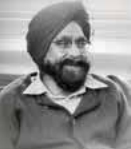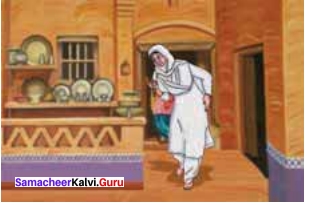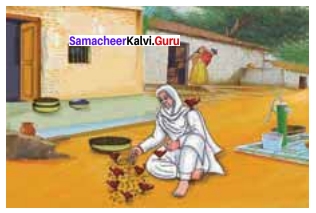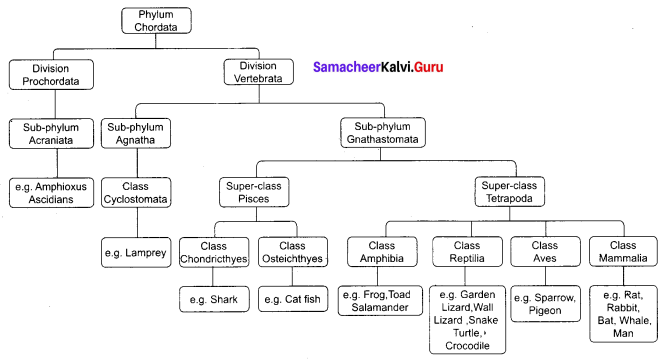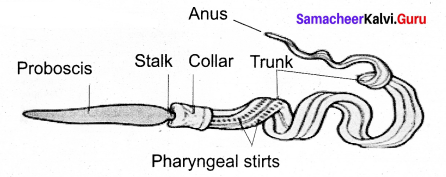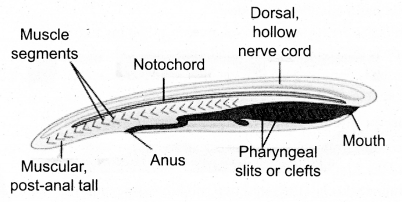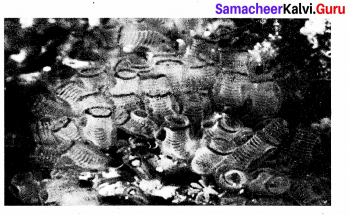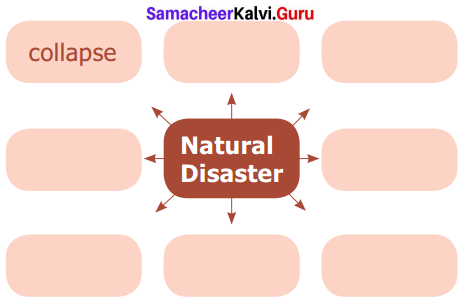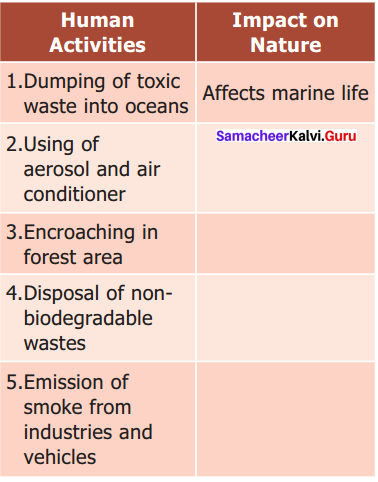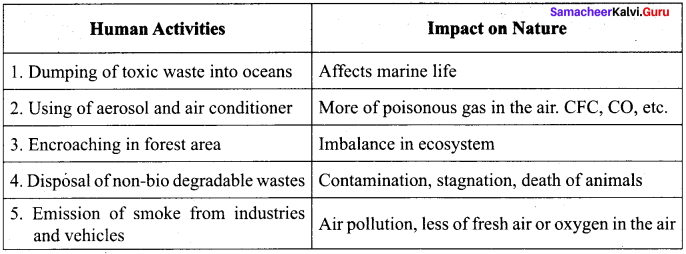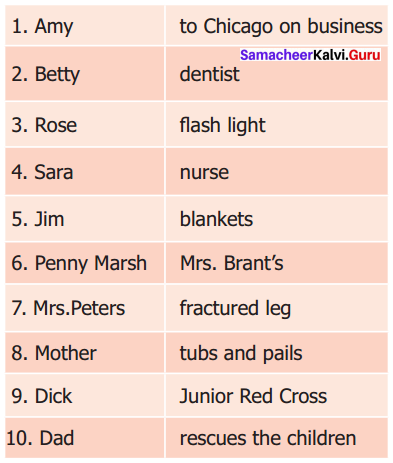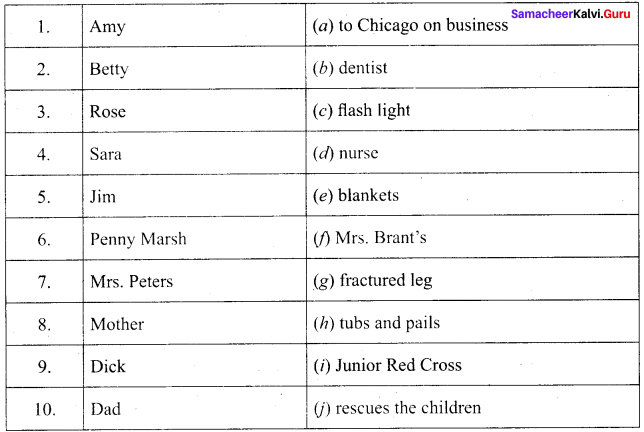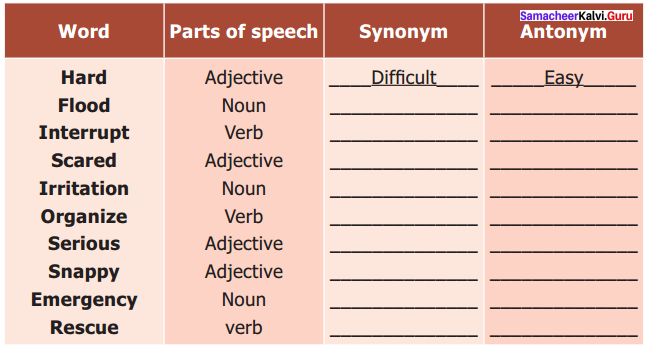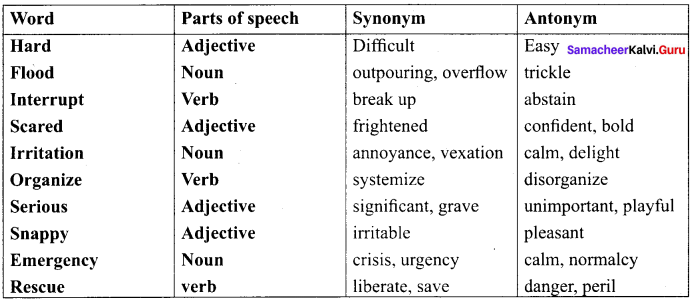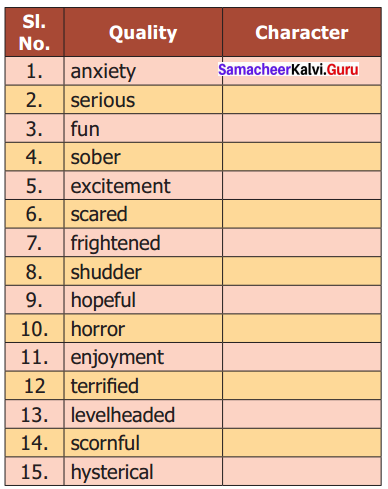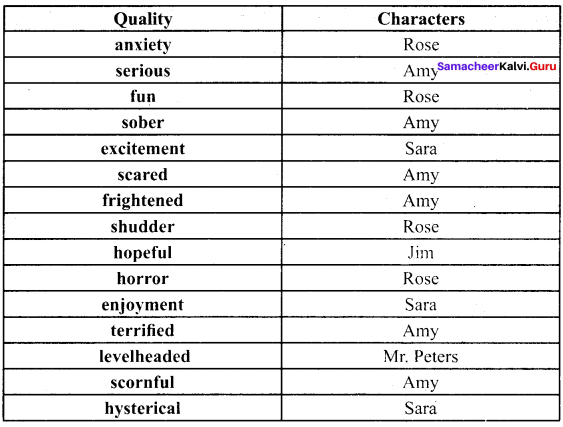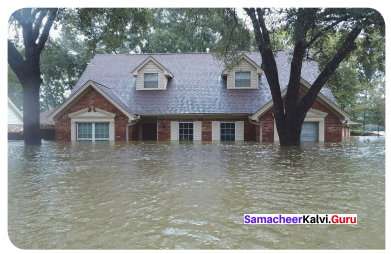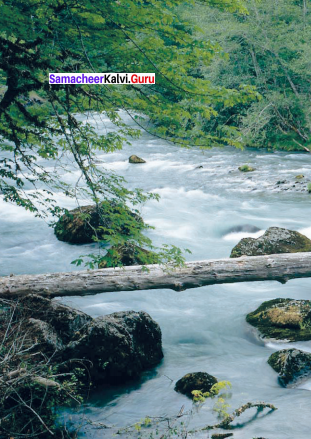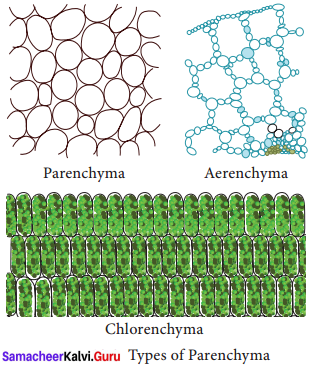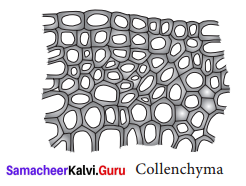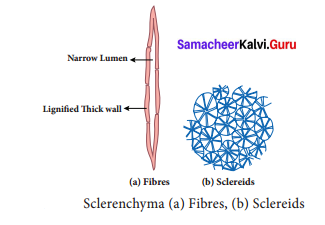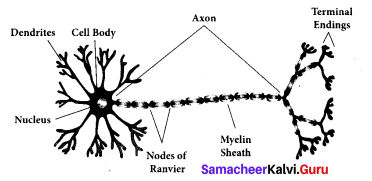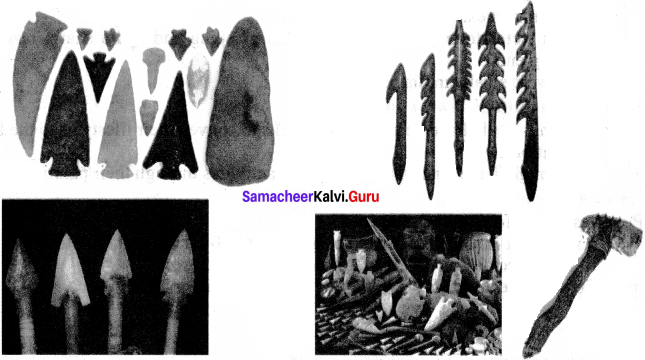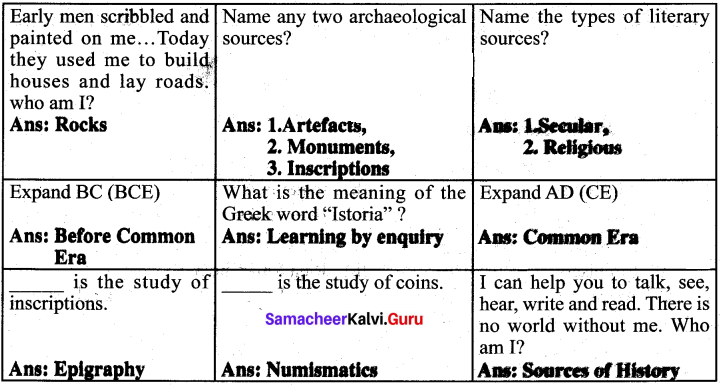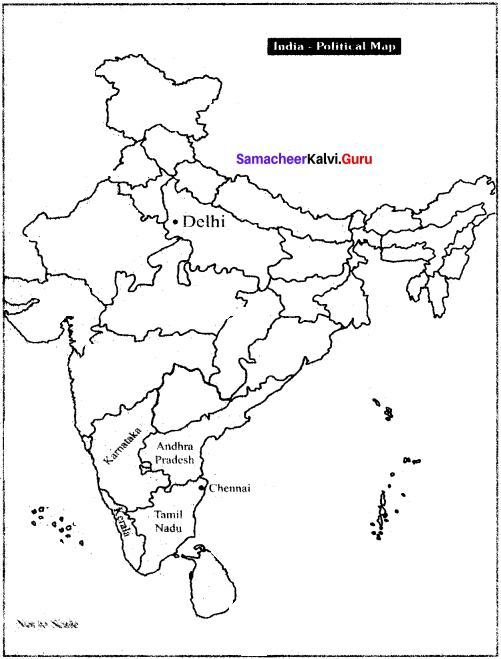You can Download Adventures of Don Quixote Questions and Answers, Summary, Activity, Notes, Samacheer Kalvi 7th English Book Solutions Guide Pdf Prose Chapter 1 helps you to revise the complete Tamilnadu State Board New Syllabus and score more marks in your examinations.
Tamilnadu Samacheer Kalvi 7th English Solutions Term 2 Prose Chapter 1 Adventures of Don Quixote
Read And Understand
Answer the following questions.
Adventures Of Don Quixote Questions And Answers Question 1.
What kinds of books did Don Quixote like to read? What were these books like?
Answer:
Don Quixote liked to read books about courageous knights and their unbelievable
adventures.
Adventures Of Don Quixote 7th English Question 2.
What effect do the things Don Quixote reads have on him?
Answer:
He was so absorbed in these stories that he never remembered to eat or sleep.
Adventures Of Don Quixote Questions And Answers Pdf Question 3.
Why didn’t Don Quixote believe Sancho Panza when Sancho told him the ogres were actually windmills?
Answer:
As Don Quixote imagined himself placed in the world of knights, he didn’t believe Sancho.
Adventures Of Don Quixote Book Back Answers Question 4.
Why do you think Sancho continued to journey on with Don Quixote after the windmill incident?
Answer:
Sancho continued his journey with Don Quixote after the windmill incident because he wanted to prevent Don Quixote from attempting anything careless.
7th Standard Adventures Of Don Quixote Questions And Answers Question 5.
When Don Quixote sees the cloud of dust on the plain in the distance, what does he think causes it?
Answer:
As Don Quixote and Sancho pass a farm, they see a thick cloud of dust. Don Quixote thinks it to be a great army marching towards them.
7th English Adventures Of Don Quixote Question 6.
Sancho sees two clouds of dust, leading him to conclude that there are two armies. What does Don Quixote think will happen next?
Answer:
He thinks that the neighing of horses, the sound of trumpets and the rattling of drums would lead to a battle between the two armies.
Adventures Of Don Quixote 7th Standard Question 7.
What is the reaction of the shepherds when they see that Don Quixote is attacking their sheep?
Answer:
The shepherds pelted stones at Don Quixote and soon, he fell wounded to the ground.
Think and Do.
Don Quixote Questions And Answers Question 1.
Most people associate windmills with Holland, rather than Spain. Use the encyclopaedia and any other sources you might have to find out more about windmills and their traditional and modern uses. Then, make a model of a windmill to display with the results of your research.
Answer:
Windmill in Holland
Historically, windmills in Holland served many purposes. The most important was pumping water out of the lowlands and back into the rivers beyond the dikes, so that the land could be farmed. In the fourteenth century, hollow-post mills were used to drive scoop wheels to drain the wetlands. In Amsterdam, we can see the “Molen de Otter”, the only wind-powered sawmill left in operation. Today, the 250-year-old windmill park is a fascinating open-air museum. The five biggest windmills in the world are located in the centre of schiedam. “Kinderdijk”
one of the best-known places for ‘windmill watching’. Its 19 windmills, almost all “grondzeilers” are on the UNESCO world heritage list. These mills, which pumped up the polder water, played an important part in shaping the Netherlands.
(Students can make a model of a windmill to display the results of their research.)
7th Standard Adventures Of Don Quixote Question 2.
Draw a design of a boat that skims trash off the surface of a river, lake, or ocean. Label the parts and give your invention a catchy name.
- What kind of vessel could do the job?
- What parts would it have?
- How would it move?
- How could it tell the difference between trash and other objects, such as animals and seaweed?
- How would it store and dump the trash?
- Could your machine double as a beach sweeper, sifting trash from sand?
Students design (draw) a boat that skims trash.
Discuss and Answer.
Adventures Of Don Quixote In Tamil Question 1.
To Dream the Impossible Dream
Don Quixote might be seen as not simply crazy in his refusal to see things as they really are but more like a person who wants to accomplish a greater good and so refuses to compromise his ideals. Examples of such people include Nelson Mandela, Mahatma Gandhi, and Martin Luther King Jr.
Discuss (with examples and other evidence) whether or not they think Quixote deserves to be put in the company of real-world idealists or is merely delusional.
Answer:
Don Quixote is a delusional romantic, who has read too many chivalric adventures. He assumes being a knight in the story and with the transforming power of illusion, makes monsters out of windmills and court-subjects out of ordinary people. This implies that the character of Don Quixote adds significant value on ordinary insignificant objects and people to suit to his perfect world of imagination.
Vocabulary
Homophones
(Homophones are two words that are spelled differently but have the same sound.)
A. Explain the difference between these words by making sentences. One is done for you.
- see/sea – Can you see the birds flying over the sea?
- knight/night – Yesterday night, I saw a knight riding on a horse.
- right/write – Write the address on the right side of the page.
- arms/alms – She stretched her arms to receive alms
- fair/fare – The auto fare was not fair.
- here/hear – I can hear the roaring sound of a lion from here.
- heard/herd – The herd of cattle heard the ratting sound of the branches.
- our/hour – It takes one hour to reach our destination.
- no/know – No one knows about this matter.
- not/knot – The knot is not tight.
Homonyms
(Homonyms are spelled the same way but differ in meaning.)
B. Read the following sentences and write the meaning of the italicised words. One is done for you.
7th Standard English Adventures Of Don Quixote Question 1.
The bandage was wound around the wound.
wound – injury
wound – past tense of wind
Question 2.
There is a fair Arts and Craft fair this weekend,
fair – good
fair – competition exhibition.
Question 3.
The woodcutter saw a huge saw in his dream,
saw – past tense of see.
saw – tool for cutting wood.
Question 4.
Write the right answers on the right side,
right – correct
right – direction
Question 5.
The well was dug by a well-known king.
well – a deep hole that is dug to get water.
well – famous
Question 6.
We have march past in March.
march – Walking in a military manner.
March – 3rd month of the year.
Question 7.
Can you get me a can?
can – A modal verb requesting permission.
can – a vessel
Question 8.
How long will the live fish live without food?
live – living and not dead.
live – remain alive.
Question 9.
She has tears in her eyes as she tears old photos.
tears – drops of liquid that come from your eyes.
tears – pull apart pr to pieces with force.
Question 10.
I will be second in line iflwait for one more second. second second
second – number a sequence.
second – duration offime.
C. Divide each word by putting a slash (/) symbol between each syllable. In the space provided, write how many syllables each word has. Use a dictionary if you’re not sure where to divide the syllables.
Syllable is a unit of pronunciation having one vowel sound, with or without surrounding consonants, forming the whole or a part of a word; for example, there are two syllables in water. Wa/ter
Answer:
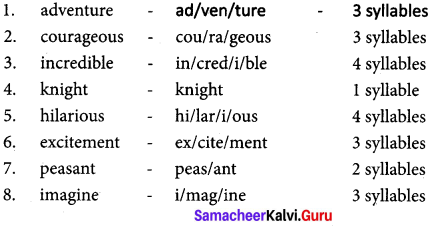
Listening
D. Listen to your teacher reading a passage on Adventure Trips. Visualize the activities. Draw the scenes in the given boxes.
There is a very famous quote by Helen Keller, “Life is either a daring adventure or nothing.” Adventure trips are all about making memories, gaining more knowledge, learning new things about the surroundings and about one’s own self and making lots of great stories. Going for an adventure camp is the best way to get all of these as it forces one to get out of their ordinary lives and try new things.
Adventure camp basically means spending the nights in tents and doing various activities at the camp-site. There are many activities included in camping to make it more exciting and interesting. Some of these are mentioned below:
Water Activities : If your camp site is near a water body then one can do aqua zorbing, water skiing, fishing, swimming, playing water volleyball and other such fun games.
Bonfire : This can be done during winter camping. Campers are made to sit surrounding the bonfire and talk about their stories or perform some acts, such as playing some instrument or singing songs.
Rock Climbing : This activity is meant to provide both physical and mental challenges to the climbers and help them in learning new skills.
Mountain biking : Just a few scratches and the trip can be memorable with new experience of driving bicycles on forest roads.
Answer:
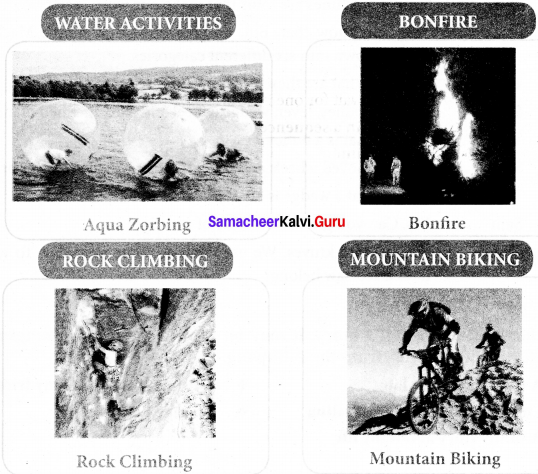
Speaking
E. Read the conversation of the simple machines. Take roles to play. Then discuss in pairs to describe any simple machine. Create your own storyboard and take roles to play.
Jack : Don’t you know how simple machines make your life easy?
Jimmy : Um I don’t know what simple machines are.
Jack : Simple machines are mechanical devices for applying force like a wedge or ramp.
Jimmy : Oh! wow! How did I not know this?
Jack : Like the wheels on hospital bed and IV pole. They help you move people faster by reducing the friction.
Jimmy : Is the stick over there that the TV is attached to, is that a simple machine too?
Jack : Yes it is, its a lever. ‘Ihe wheels on the bus are simple machines, they make the bus move.
Jimmy :What about the doors?
Jack : Yeah the driver pulls a lever and the doors open and you climb up the inclined plane also known as the stairs. The cable in the elevator is wrapped around a groove in the wheel and axle, an electric motor pulls the cable, lifting the car between floors.
Jimmy : So the wheels on the rolling chair are too by rolling the chair back instead of lifting the chair back.
Jack : Yes theyare, they move the chair and reduce the friction.
Answer:
Tom : Simple machines are tools that make our work easier.
Sam : Yes, I do know that. But, do you know that simple Machines can be broken down into six different categories.
Tom : Is it so? What are these different categories?
Sam : They are pulley, lever, wedge, wheel and axle, inclined plane and screw. Wow! What is a pulley?
Tom : It uses grooved wheels and ropes or chains to raise, lower or move a load. I know that a wedge is an object with a sharp slanted.
Sam : Yes. Can you give an example of a wedge?
Tom : Scissors and knives. We use them at home everyday. To what category does a see-saw belong?
Sam : It is a lever.
F. Ask the students to tell a story. It may be a true story or an imaginative story. Choose one of the titles from the following.
- A time l was very late
- A funny story about my friend
- met someone very Interesting
- An unusual event
- A funny story about my life
Answer:
A funny story about my friend.
In the year 2018 my friend had a severe eye pain. He consulted many physicians, but none could treat his ache. At last, he approached a wise monk who carefully observed his eyes and offered a very peculiar solution. The monk told him to concentrate only on green colour for a few weeks and avoid any other colour. My friend was very desperate to get rid of the pain. So he was determined to go to any extent. He appointed a group of painters and directed them to paint every thing in green colour. As I was working in his office, I was surprised to see all this.
After a few weeks, the monk came to visit him to follow up on his progress. As the monk was walking towards the man’s room, the appointed painter poured a bucket of green pain on the monk. The monk enquired about the reason for painting everything green. My friend told him that he was only following the monk’s advice to look at only green. At this, the monk laughed and said, ‘If only you had purchased a pair of green spectacles, you could have saved a large share of your fortune. You cannot paint the world green? .
Moral: So let us change our vision and the world will appear accordingly.
Think about your story
- When did It happen?
- Where were yon?
- Who was there?
- What happened?
Answer:
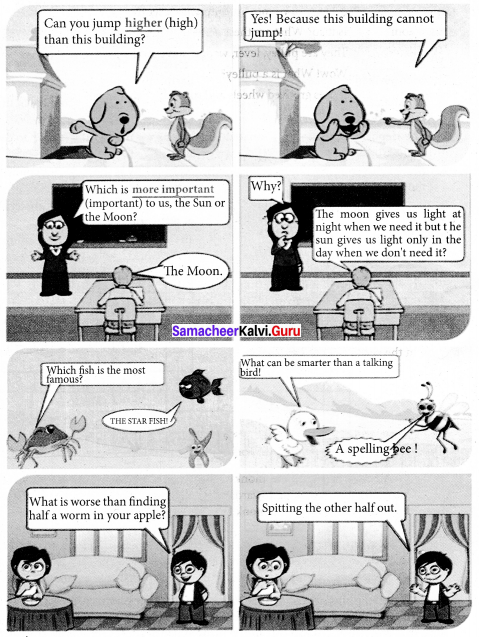
Picto Grammer
G.Solve the crossword puzzle using superlative adjectives.
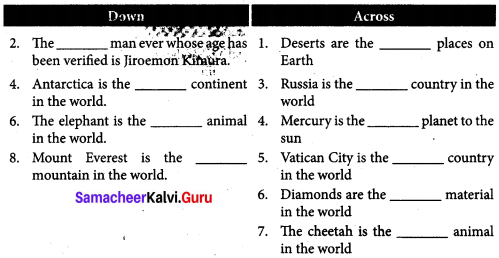
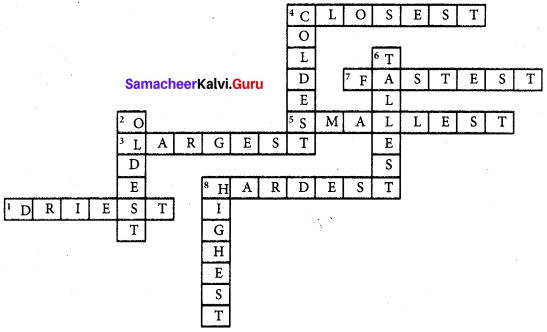
H. Put students in pairs and tell them to interview their partner. To do this they must make questions, e.g. What’s the worst storm you’ve ever seen? They can also ask follow-up questions to find out more information. Do feedback on this as a whole class. Other thematic questionnaires of this kind could be:
Emotional experiences
- The most frightened I’ve ever been …
- The happiest moment I’ve ever had …
- The most nervous I’ve ever been …
Musical experiences
- The best song I’ve ever heard …
- The worst song I’ve ever heard …
- The longest time I’ve ever danced …
Places in your life
- The most dangerous place I’ve been in ..
- The cheapest restaurant I’ve eaten in …
- The most boring town I’ve ever visited ..
Answer:
Student 1 : What was the happiest moment your’ve ever had?
Student 2 : The happiest moment was when I received the best award for the Elocution competition in the national level.
Student 1 : How did you feel about that award?
Student 2 : I felt very proud to receive the award in front of all the dignitaries.
Student 1 : Were you nervous to be on the stage?
Student 2 : Yes, at first I was nervous to speak to the audience. But then, after some time, I became normal.
Student 1 : Did you ever dance on the stage?
Student 2 : Yes, I had danced on the stage for the Annual School day celebration.
Student 1 : Excellent! You had a very good opportunity to exhibit your talents and you had utilized the opportunity successfully.
Writing
I. Write a paragraph comparing Don Quixote and Sancho Panza. The following words will help you to write a compare and contrast paragraph
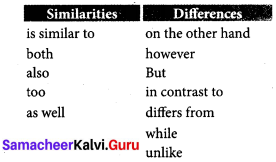
Answer:
The relationship between Don Duixote and Sancho Panza is an important one. Readers can easily understand that the two characters stand for different things. Don Quixote represents illusion. On the other hand Sancho Panza represents reality. They complement each other in a dualistic way
Sancho Panza was a peasant labourer. He was greedy, but kind and faithful. He was also a coward. He is a foil to Don Quixote and virtually to every other character in the story. Don Quixote sees what his mind and imagination create, not which is actually
there. He retreats to a world that holds meaning for him. He wants to be a knight in search of his own adventures, winning fame and honour. Unlike Don, Sancho is more practical. He seeks fortune and has a lot of common sense. But he consistently defers with his master and assents to dangerous schemes. However, Don Quixote despite his folly, Superior to the real world he has to deal with
Creative Writing
j. Local Historians
- Ask students to collect stories about their town from older people.
- Ask them to find out how the streets were named.
- Are there any interesting people or legends to which the street names refer?
- Are there any local places in town about which people tell stories?
- Any haunted house?
- Let students find out when the town was founded and by whom.
- Visit a local historical society to see old photographs or artefacts.
Let student create an original historical fiction :
Describe the town from the point of view of a fictitious citizen who might have lived in the town long ago. Include local issues of the time in the story. Write the story of the town from the fictionalized point of view of a resident who actually lived there.
Activity done by the Students.
Adventures of Don Quixote Additional Questions
I. Choose the correct Synonyms from the options below.
Question 1.
courageous
(a) daring
(b) timid
(c) coward
(d) fearsome
Answer:
(a) daring
Question 2.
exciting
(a) depressing
(b) annoying
(c) thrilling
(d) arousing
Answer:
(c) thrilling
Question 3.
incredible
(a) believable
(b) unbelievable
(c) fact
(d) truth
Answer:
(b) unbelievable
Question 4.
hilarious
(a) frightening
(b) boring
(c) amusing
(d) fascinating
Answer:
(c) amusing
Question 5.
sparkle
(a) shine
(b) glimmer
(c) shade
(d) dark
Answer:
(a) shine
Question 6.
hideous
(a) beautiful
(b) pleasant
(c) oily
(d) ugly
Answer:
(d) ugly
Question 7.
combat
(a) peace
(b) fight
(c) retreat
(d) accord
Answer:
(b) fight
Question 8.
exploits
(a) achievements
(b) devastation
(c) failure
(d) waste
Answer:
(a) achievements
Question 9.
dissuade
(a) permit
(b) prevent
(c) encourage
(d) attract
Answer:
(b) prevent
II. Pick the correct Antonyms
Question 1.
same
(a) different
(b) alike
(c) real
(d) true
Answer:
(a) different
Question 2.
serious
(a) trivial
(b) severe
(c) funny
(d) silly
Answer:
(c) funny
Question 3.
faithful
(a) loyal
(b) dedicated
(c) unfaithful
(d) devoted
Answer:
(c) unfaithful
Question 4.
collided
(a) clashed
(b) missed
(c) agreed
(d) ascended
Answer:
(d) ascended
Question 5.
charged
(a) retreated
(b) denied
(c) attacked
(d) bored
Answer:
(a) retreated
Question 6.
defeated
(a) won
(b) beaten
(c) surrendered
(d) destroyed
Answer:
(a) won
Question 7.
reckless
(a) careless
(b) careful
(c) headless
(d) thoughtless
Answer:
(b) careful
Question 8.
disorder
(a) order
(b) mess
(c) chaos
(d) confusion
Answer:
(a) order
Question 9.
taunted
(a) insulted
(b) teased
(c) ridiculed
(d) praised
Answer:
(d) praised
Question 10.
embarrassed
(a) unsettled
(b) ashamed
(c) proud
(d) shameless
Answer:
(c) proud
III. Choose the Correct Answer (MCQ).
Question 1.
As years passed, Don Quixote imagines himself placed in the world of _____
(a) kings
(b) princes
(c) knights
(d) soldiers
Answer:
(c) knights
Question 2.
He convinces Sancho Panza, a _____from the same village to be his sauire.
(a) woodcutter
(b) well wisher
(c) attendant
(d) peasant
Answer:
(d) peasant
Question3.
Don sets on a _____ in search of a sauire.
(a) journey
(b) voyage
(c) trip
(d)tour
Answer:
(a) journey
Question 4.
Sancho’s shouts and warnings Passed _____
(a) heedless
(b) unheard
(c) untold
(d) careless
Answer:
(b) unheard
Question 5.
Don Quixote’s eyes began to _____
(a) shine
(b) brighten
(c) sparkle
(d) dazzle
Answer:
(c) sparkle
VI. Very Short Questions with Answers.
Question 1.
Where did Don Quixote live?
Answer:
He lived in a village called La Mancha in Spain.
Question 2.
What comes alive in the hilarious account of Don Quixote’s travels?
Answer:
The days of knight and squires of exciting adventures come alive in Don Quixote travels.
Question 3.
Who does he convince to be his squire?
Answer:
He convinces Sancho Panza, a poor peasant to be his squire.
Question 4.
How does he convince Sancho?
Answer:
He convinces him by rewarding him with an island, if he serves him faithfully.
Question 5.
Where did they see a large windmill?
Answer:
They saw a large windmill on the hill in front of them.
V. Short Questions with Answers.
Question 1.
Were Sancho’s warnings heard by Don Quixote? What did he do?
Answer:
Sancho’s shouts and warnings were not heard by Don Quixote. He flew towards the windmill and collided with it.
Question 2.
What did Don Quixote tell Sancho about the windmill, after his attack on it?
Answer:
He told his squire Sancho that the ogre (windmill) was more seriously wounded than him.
Question 3.
What did Sancho do to prevent Don Quixote from attempting anything reckless?
Answer:
Sancho did his best to prevent Don Quixote from attempting anything else reckless. Even though the windmill was working perfectly, he supported Don’s deeds.
Question 4.
What did Don do, when he saw a thick cloud of dust?
Answer:
He thought that they were a great army marching towards them. So he started to name the leaders and the principal knights in each army and described different nations.
Question 5.
What did Don Quixote do to his horse?
Answer :
He set spurs to his horse Rozinante, and charged into the midst of the sheep.
VI. Paragraph Questions with Answers.
Question 1.
How did Don Quixote brush aside the warnings given by his squire?
Answer:
Don Quixote and Sancho Panza set out on a journey together. They saw a large old windmill on a hill. When Don imagined it to be an ogre, Sancho warned him saying that it was only a windmill. But Don brushed aside his warnings asking him to go aside and say his prayers, if he was afraid of them. Again when they saw a dust of cloud, Don thought they were two armies marching towards them. Sancho told him that they were only sheep and lambs. Don paid no heed to him and told him that his fears prevent him from hearing or seeing right.
Question 2.
What did Don Quixote do to the sheep and lambs? How did the animals and the peasants react?
Answer:
Don Quixote set spurs to his horse Rozinante and charged into the midst of the sheep and lambs. At this, the frightened animals fled helter-skelter. The shepherds seeing the cause of their disorder, pelted stones at Don Quixote. He soon fell wounded to the ground. All the local peasants thought that Don Quixote was crazy. As he passed, they laughed and insulted him. Don thought that they were praising him. But Sancho told him that they were only mocking at him.
Adventures of Don Quixote Vocabulary Additional
Homophones
A. Explain the difference between these words by making sentences.
1. no/know : Do you know the answer? No. I don’t.
2. wear/where : Where do you wear woollen clothes?
3. hare/hair : The colour of your hair is the same as that of the hare.
4. steel/steal : He tried to steal the jewels from the steel almirah.
5. by/buy : He wants to buy a flat by selling his old house.
Homonym
B. Read the following sentences and write the meaning of the italicised words.
1. He hit the bat with his bat.
bat – a mammal
bat – sport equipment (cricket bat)
2. I did not object to the object
object – protest
object – aim (or) purpose
3. I was content to write the whole content of the book,
content – willing to accept
content – the subjects or topics covered in a book
4. They were too close to the door to close it.
close – being near
close – to shut
5. Don’t park your car near the park.
park – to leave a vehicle
park – a public land for recreation
C. Divide each word by putting a slash (/) symbol between each syllable and write how many syllables each word has..
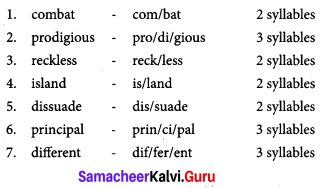
Adventures of Don Quixote Grammer Additional
Degrees of Comparision
| Positive | Comparative | Superlative |
| bad | worse | worst |
| clever | cleverer | cleverest |
| dark | darker | darkest |
| delicious | more delicious | most delicious |
| easy | easier | easiest |
| good | better | best |
| much | more | most |
| wise | wiser | wisest |
A. Choose the Correct Answer.
Question 1.
He is the _____ musician.
(a) good
(b) better
(c) best
Answer:
(c) best
Question 2.
Ravi s handwriting is _____ than that of Muthu.
(a) good
(b) better
(c) best
Answer:
(b) better
Question 3.
He is a _____ person.
(a) good
(b) better
(c) best
Answer:
(a) good
Question 4.
Your answer is the _____ relevent.
(a) more
(b) more than
(c) most
Answer:
(c) most
Question 5.
The Ganges is the _____ river of India.
(a) long
(b) longer
(c) longest
Answer:
(c) longest
Question 6.
Rajasthan is the India’s _____ state by area.
(a) large
(b) largest
(c) larger
Answer:
(c) larger
Question 7.
Goa is the _____ state of India by area.
(a) smallest
(b) smaller
(c) small
Answer:
(a) smallest
Question 8.
Ganesh is the _____ boy in the class.
(a) tall
(b) taller
(c) tallest
Question 9.
He is the _____ player in the team.
(a) good
(b) better
(c) best
Answer:
(c) best
Question 10.
Jupiter is the _____ of all planets.
(a) big
(b) bigger
(c) biggest
Answer:
(c) biggest
Warm up
My Hand of Imagination :
- Trace around your hand on a white paper.
- Make a list of your five choices.
- Draw a picture to indicate what your finger would become.
- Erase one finger at a time and draw your choice in its place.
- Write and share in the class.
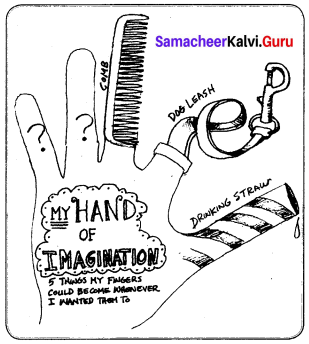
Answer:
- Pencil
- Spoon
- Scale
- Pen
- Writing Pad
Adventures of Don Quixote Summary
There lived a middle aged man in a village called La Mancha in Spain. He loved to read books about courageous knights and the unbelievable adventures they had experienced. He involved himself so much in these adventurous stories that he imagined himself to be one of them. He convinced a poor farmer Sancho Panza to be his squire. The two men set out on a journey together. On the way, they saw a large windmill. Don Quixote imagined it to be an ogre, who was blocking their path. Though his squire tried to convince him that it was only a windmill, he didn’t believe him. He fought with the windmill and got knocked off his horse. Sancho did his best to dissuade Don Quixote from attempting anything reckless.
As they were passing a farm, they saw a thick cloud of dust. Don Quixote thought it to be a great army, marching in their direction. But Sancho knew that they were only sheep and lambs. Paying no heed to his squire, he charged at them with his horse Rozinante. The local farmers thought that he was crazy. They laughed and insulted him. Don Quixote did not understand them. He thought that the people were cheering him. He returned to his estate and realized that all his adventures were simply a product of his imagination. So he never embarrassed himself by going on any more quests. But he lived happily imagining and narrating the most fantastic stories about knights and squires to all the children.
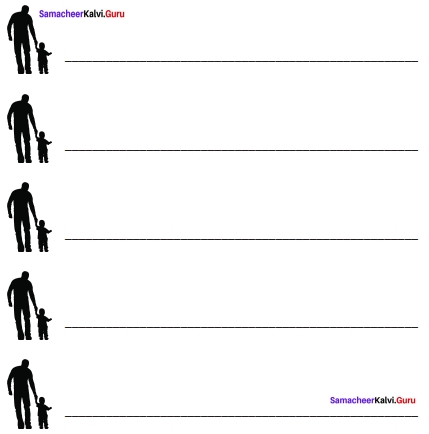
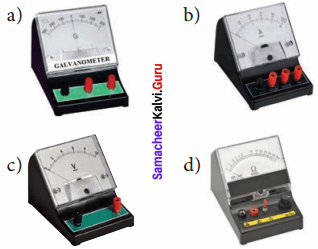
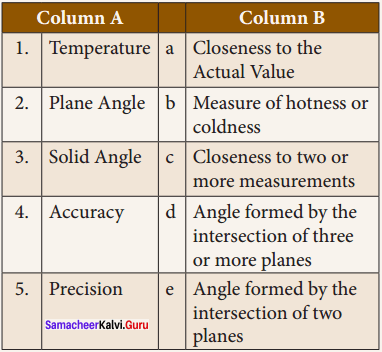

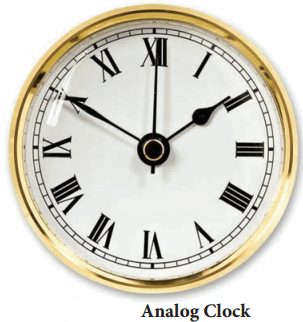
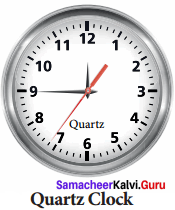


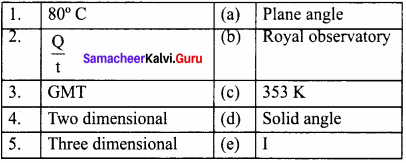
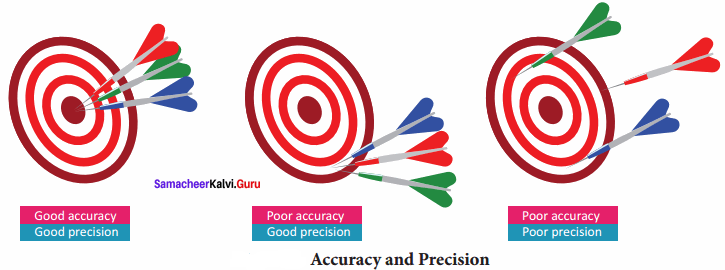
 Answer:
Answer: